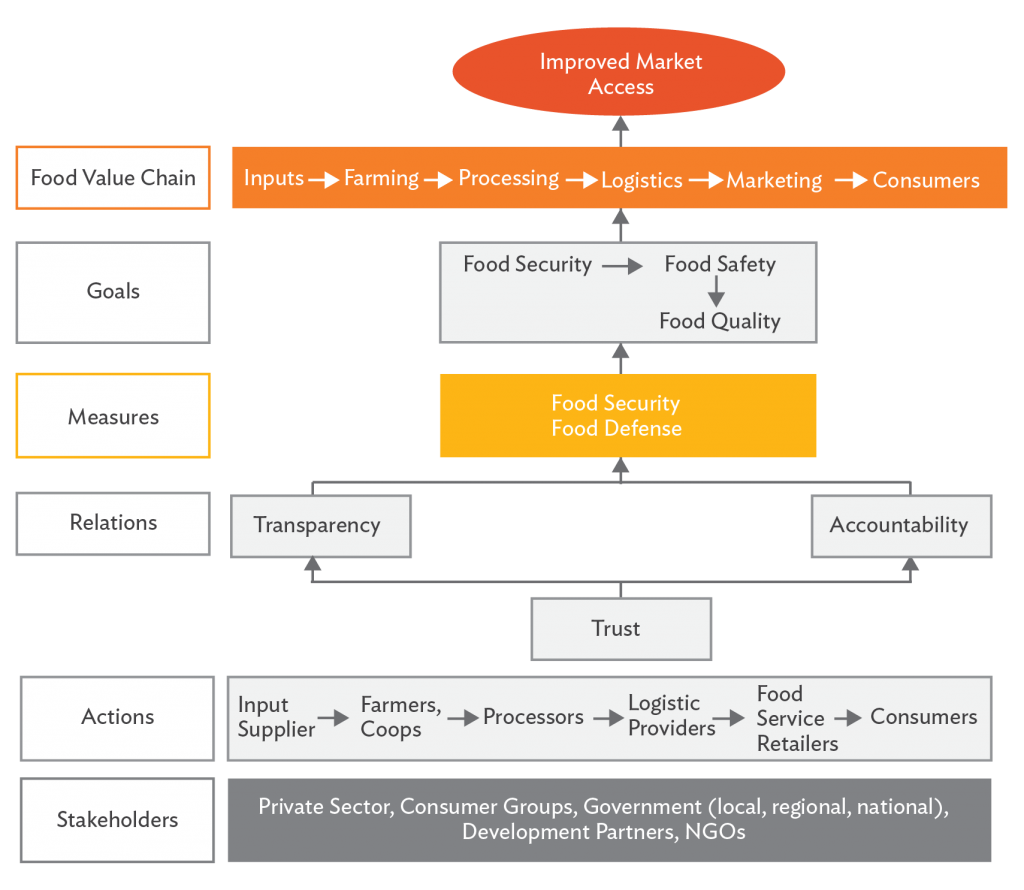
Establishing a Sustainable Food Supply for the Greater Mekong Subregion
A regional approach to food policy driven by business and public interests can better protect consumers and suppliers in both domestic and export markets, support scaling up of production, and facilitate market access and Greater Mekong Subregion product branding and marketing.
The Greater Mekong Subregion (GMS) is a perennial global leader in exporting key commodities—such as rice, coffee, and cashews. Intra and extra-GMS trade in a variety of agro-food products continue to grow strongly year-on-year, while infrastructure, trade facilitation and business environments are improving and the subregion is attracting increasing foreign direct investment in agriculture. However, the subregion’s current pest, disease, and residue issues hamper production, food safety, and market access while local environmental degradation and the impacts of climate change threaten the sustainability of some systems.
Key challenges
The GMS countries have made great progress in reforming national policies, enacting legislative and regulatory systems, and increasing food security; however, gaps remain and strategic investments, policy changes, and institutional capacity building are needed to ensure the sector’s continued development.
Food safety and quality assurance are key challenges facing the global food sector, are a core component of food security, and form a major barrier to market access for the GMS countries.
Food safety issues have become a priority for each GMS country in recognition of the high economic and social costs and in response to frequent headlines highlighting failures and scandals and consumer demand. Food safety failures cost the GMS economies billions of dollars per year in healthcare, lost labor and tourism, reduced demand for GMS products, and rejected consignments.
Further, as the GMS countries become more integrated—collectively and with wider global markets—and as cross-border value chains continue to develop, it is imperative that the subregion’s food suppliers meet domestic and export market standards (from the farm to the consumer’s table) to remain competitive.
Current policy and institutional gaps and priorities for investment need to be identified. It is essential that producers and the wider business community work closely with policymakers to develop unified regional approaches to address food safety. Establishing unified food safety systems that better protect consumers and suppliers in an inclusive and economically and environmentally sustainable manner is a recognized goal of the GMS countries.
The systems are also needed to unlock markets for safe and environment-friendly GMS agro-food products.
The subregion’s agriculture is also threatened by local environmental degradation and the impacts of climate change. Identifying the best practices for building sustainable, resilient, and productive agricultural systems can reduce food safety risks presented by the inappropriate use of synthetic agrochemicals such as fertilizers and plant protection products.
New supply models
Extensive research and development (R&D) on these topics is being conducted within the GMS. New supply models are being trialed and in many cases are gaining support, such as the participatory guarantee system (PGS) of peer-based assurance of organic production practices. The outcomes of these initiatives need to be shared within the region and the policy, institutional, and investment implications communicated to all public and private sector stakeholders.
Agricultural market value chains are typically complex and dynamic, nowhere more so than in the GMS. Strong economic growth, high rates of urbanization, and changing retail and consumption patterns are just some of the factors influencing food supply in the subregion.
Moreover, with regional economic integration increasing through the establishment of the ASEAN Economic Community, GMS agricultural interests are confronting stiffer competition while being presented with new opportunities to link with multicountry processing and distribution networks. Developing a greater understanding of the mechanisms through which products, value, and information are generated and shared among stakeholders in GMS agricultural product supply is essential to identify and address the constraints and bottlenecks that currently hamper efficiency, limit market access, and product differentiation, and present risks to suppliers and consumers.
Although agricultural supply in the GMS is extremely diverse, some key threats and opportunities are apparent across countries and products, making a detailed investigation of select value chains and value chain issues pertinent to sector decision-making more broadly.
The figure below shows the interdependence of food safety and market access of the GMS with organizational and individual relations of stakeholders in the food value chain.

Geographical indication
Considerable interest in geographical indication (GI) exists among key actors within the GMS countries, both policymakers, and the private sector. The geographical indication can protect local producers, their traditions, and their incomes while promoting biodiversity, food safety, and environmental sustainability.
Coordination of GI legal frameworks in the GMS countries and mutual recognition can benefit each country and individual GIs by increasing access to wider markets, generating scale, and building consumer recognition of GI designation as a sign of quality and value.
Sharing experiences, lessons, and best practices among GMS countries can help to establish more effective and efficient registration and enforcement systems that adequately protect the reputation of GI and establish GMS GI products among those that consumers in the GMS and further afield value most.
This article is an edited version of a report's summary published by Development Asia.
